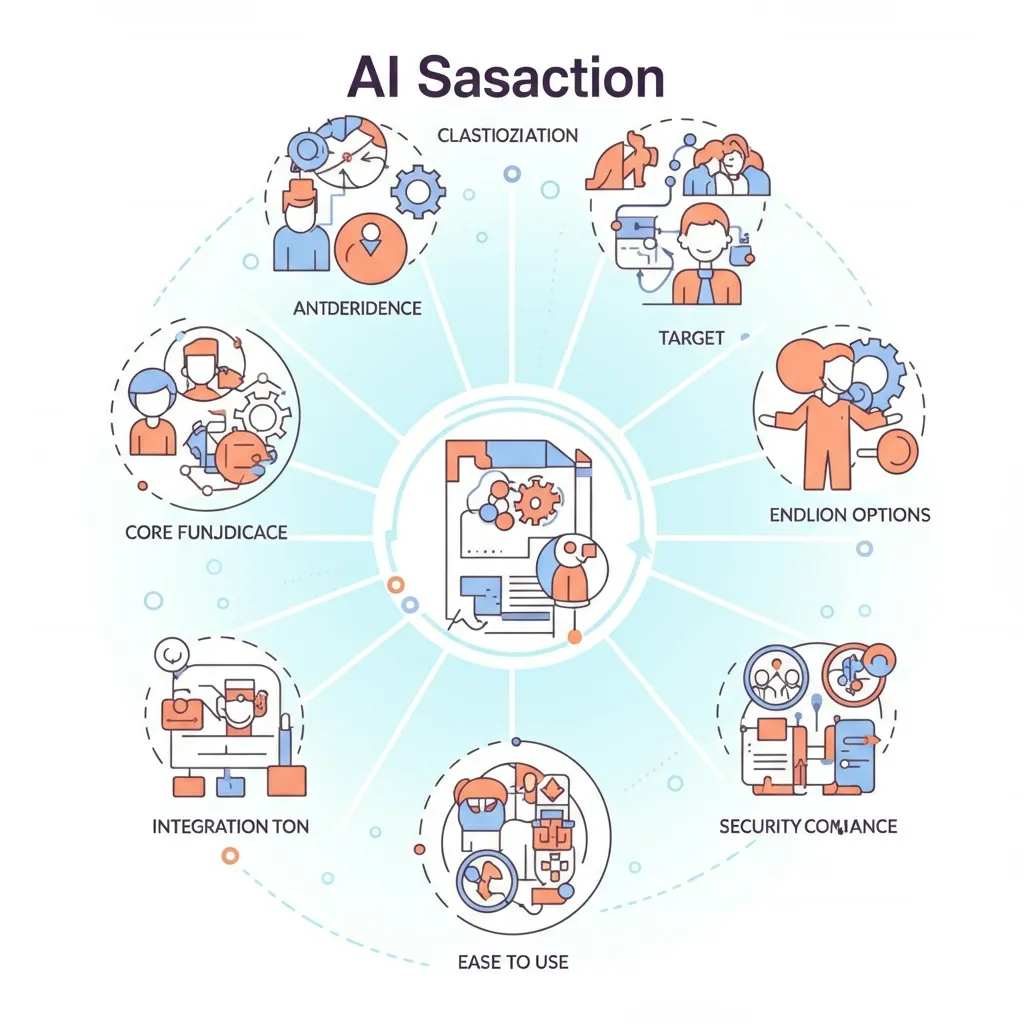The rapid growth of Artificial Intelligence (AI) in Software as a Service (SaaS) has paved the way for groundbreaking tools that transform industries across the globe. However, as the market expands, businesses, developers, and users face a challenge classifying and understanding the nuances of AI SaaS products.
Clear classification is essential to identify the best solutions, ensure compliance, and stand out in an overcrowded market.

This comprehensive guide dives into the critical criteria for AI SaaS product classification, drawing insights from top-ranking blogs while adding actionable tips and closing any gaps.
Whether you're a product manager, developer, or end-user, this blog will arm you with the framework you need to navigate the dynamic AI SaaS landscape.
Why Is AI SaaS Product Classification Important?
AI SaaS products are not one-size-fits-all solutions. From customer support platforms to predictive analytics tools, these products vary widely in their purpose, AI integration, target industry, and user interaction. A robust classification system offers several key benefits:
1. Improved decision-making – Helps businesses choose the most relevant tool based on their needs and goals.
2. Enhanced compliance – Ensures the product aligns with industry regulations like GDPR or HIPAA.
3. Optimised marketing strategies – Makes it easier for vendors to communicate a product's unique value.
4. Streamlined scaling and integration – Aids developers in designing scalable solutions.
Without proper classification, businesses risk adopting tools that lack compatibility, compliance, or the ability to address their challenges effectively.
Key Criteria for AI SaaS Product Classification
To categorise AI SaaS products effectively, it’s important to evaluate them across multiple dimensions. Below are the primary criteria to consider:
1. Purpose and Functionality
The fundamental purpose and functionality of an AI SaaS product determine how it serves users. Ask yourself:
● What problem does it solve?
● Does it focus on automation, data analysis, customer support, or another area?
For example, tools like Zendesk AI are tailored for customer service automation, while platforms like Tableau use AI to enhance data visualisation and analytics.
By clearly identifying a product’s role, businesses can quickly narrow their options to align with operational needs.
Pro Tip: Group products into key categories based on functionality, such as predictive analytics, decision-making, or natural language processing (NLP).
2. Target Market and Industry
AI SaaS tools often cater to specific industries, offering solutions tailored to unique challenges. For instance:
● Healthcare tools focus on patient diagnostics and data security.
● Retail products provide personalised shopping recommendations.
● Financial services prioritise fraud detection and compliance.
Define whether the product targets small and medium enterprises (SMEs), large enterprises, or both. Only by aligning tools to industry demands can businesses ensure relevance to their target audience.
3. AI Maturity and Capability
Evaluate the level of sophistication of a tool’s AI:
● Basic automation – Automated workflows, such as email replies or task schedulers.
● Machine learning (ML) – Predictive tools with data analysis capabilities.
● Advanced AI – Platforms that utilise deep learning or reinforcement learning for complex decision-making.
For example, Grammarly uses AI for real-time grammar corrections, while tools like Gong.io leverage machine learning for sales conversation analytics.
4. User Interaction and Experience
No matter how advanced the tech, the user experience impacts adoption rates. Examine:
● Ease of use – Is the interface intuitive?
● Customisation – Does the product cater to user-specific workflows?
● Human-AI collaboration – Does it feature human-in-the-loop systems for accountability?
A smooth user experience enhances adoption and retention, making it a critical classification factor.
5. Deployment and Scalability
AI SaaS solutions come with varying deployment models:
● Cloud-native – Hosted on multi-tenant public clouds for scalability (e.g., Slack or HubSpot).
● On-premises – More suitable for industries like healthcare, where data privacy is paramount.
● Hybrid or edge AI – Combines on-prem solutions with cloud access, ideal for sectors requiring high-speed performance.
For example, AI SaaS solutions like Salesforce Einstein offer hybrid deployment options to support enterprise-level customisation.
6. Data Privacy and Compliance
AI SaaS tools interact with sensitive data, so compliance with data protection standards is vital. Common frameworks include:
● GDPR – For businesses dealing with European Union residents’ data.
● HIPAA – Governing healthcare tools managing patient information.
Additionally, vendors should prioritise transparency:
● Explainable AI (XAI) – Clearly show how decisions are made.
● Audit trails – Offer compliance officers access to decision-making processes.
Tools with stronger compliance mechanisms are naturally classified as enterprise-grade solutions.
7. AI Dependency

Understand whether the SaaS product relies entirely or partially on AI:
● AI-native products are built around AI (e.g., tools like ChatGPT).
● AI-augmented products use AI to improve legacy functions (e.g., AI for email scheduling within Gmail).
This classification dimension helps businesses evaluate the role of AI in their operations. Read more about Web3 Game Development Services
8. Cost and ROI
Cost isn’t just about subscription fees; evaluate:
● Short-term operational savings (e.g. reducing repetitive manual tasks).
● Long-term ROI, including AI learning capabilities that improve efficiency over time.
Investing in tools like HubSpot AI can offer cost advantages by optimising marketing campaigns.
9. Support and Maintenance
Consider the customer support offered:
● Proactive updates – Regular improvements based on feedback.
● 24/7 support – Essential for mission-critical tools like those used in finance or healthcare.
Well-supported products lead to better user satisfaction and easier integration into existing infrastructures.
Gaps in Existing Approaches to AI SaaS Classification
While most blogs cover the primary classification dimensions, some gaps persist, including:
● Continuous Learning Systems
Classification should evaluate whether AI-driven SaaS products include adaptive learning mechanisms, which refine performance over time.
● Multi-modal Capabilities
Assess whether tools support multi-modal inputs, such as text, images, or voice.
● API Integrations
Evaluate the ecosystem a SaaS solution fits into by examining its API and third-party support.
These additional dimensions improve the clarity and functionality perspective of any classification system.
Practical Steps for Buyers and Developers
For SaaS Buyers
● Evaluate user reviews to gauge compliance and usability.
● Compare AI maturity among tools in the same category.
● Demand transparency in how the AI platform uses collected data.
For SaaS Developers
● Prioritise transparency by building explainability features.
● Provide industry-specific compliance settings for easy adoption.
● Design with scalability to accommodate enterprise-level requirements.
The Future of AI SaaS Product Classification

AI technologies evolve rapidly, and so will their classification systems. Expect the following trends:
● Standardisation of Metrics – Unified global standards to assess AI products.
● AI Governance Requirements – Increased focus on bias detection, fairness, and ethical AI design.
● Cross-industry Applications – Tools will diversify to meet increasingly specific niche requirements.
By adopting a rigorous classification framework now, businesses can future-proof their choices as the landscape grows more sophisticated.
Closing Thoughts
Classifying AI SaaS products is no longer optional it’s essential for successfully adopting, deploying, and scaling AI driven technologies.
An effective classification system enables businesses to identify tools that address their unique needs while ensuring transparency, compliance, and efficiency.
By understanding this framework and addressing potential gaps, both buyers and developers can optimise operations and drive innovation in new ways.
Are you ready to revolutionise the way you adopt AI-powered tools? Start by carefully analysing your business needs and matching them to the right criteria for AI SaaS classification.
FAQ Section for AI SaaS Product Classification
What is AI SaaS?
AI SaaS stands for Artificial Intelligence Software as a Service. It refers to cloud-based platforms that use AI algorithms to automate tasks, analyse data, or personalise user experiences.
These tools are accessible through a web browser and typically operate on a subscription model.
How do I choose the right AI SaaS product?
Selecting the best AI SaaS product for your needs involves evaluating your goals and resources. Consider the following steps:
● Assess your business challenges and pain points.
● Look for features that align with your goals (e.g., automation, analytics, or customer personalisation).
● Check the scalability of the solution.
● Evaluate pricing plans and ensure they match your budget.
● Verify customer support and training availability.
What are the key classification criteria for AI SaaS products?
When evaluating AI SaaS tools, classify them based on these criteria:
● Core Functionality – Does it focus on task automation, data analytics, natural language processing, or another AI-driven function?
● Target Audience – Is it aimed at enterprise users, small businesses, or individuals?
● Customisation Options – Can it adapt to your specific business workflows?
● Integration Capabilities – Does it work seamlessly with your existing tools?
● Ease of Use – Is the interface intuitive for your team?
● Security and Compliance – Does it meet industry standards for data protection?
Are AI SaaS products suitable for small businesses?
Absolutely! Many AI SaaS providers offer solutions tailored to small businesses with affordable pricing and simplified features.
These tools can help automate repetitive tasks, improve decision-making with data insights, and enhance customer engagement even with limited resources.
How secure are AI SaaS platforms?
Most modern AI SaaS platforms comply with strict security standards, including data encryption, regular updates, and compliance with regulations like GDPR or HIPAA.
However, always review the provider's security measures to ensure compliance with your internal requirements.
Can I scale AI SaaS solutions as my business grows?
Yes, that’s one of the primary benefits of SaaS solutions. AI SaaS platforms typically offer tiered plans that allow you to upgrade your service as your needs evolve.
What kind of support do AI SaaS providers offer?
Support services vary between providers but often include:
● Documentation and user guides.
● Onboarding tutorials.
● Customer service (via chat, email, or phone).
● Dedicated account managers for premium customers.
How do I evaluate ROI for AI SaaS products?
To measure ROI, consider:
● Increased efficiency and reduced workload.
● Enhanced decision-making accuracy through data insights.
● Growth in customer satisfaction and retention.
● A defined reduction in operational costs.
Need help creating an AI SaaS solution tailored to your needs?
We offer bespoke SaaS development services to bring your unique vision to life. Place your new web order here to get started!


